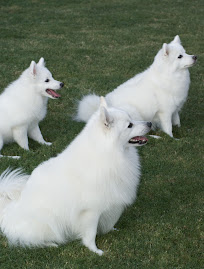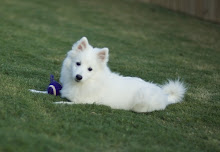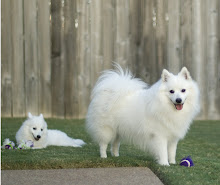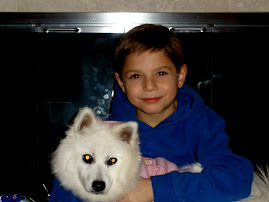Keeping Up With Pet Food Recalls
January 30, 2010
If you're anything like me, every time you feed your dog commercial dog food, you think about the many pet food recalls that have taken place this past decade. It can be overwhelming at times to try to keep up with the numerous recalls. Not only do you have to figure out where to go to locate the information, but you have to determine whether the information you have obtained is accurate.
Well, I have good news! The U.S. Department of Agriculture and the U.S. Department of Health and Human Services have joined forces to launch a new food-safety consumer website (http://www.foodsafety.gov/) that, fortunately, includes pet food recall information. The website is updated with the latest announcements from the federal government, as well as tips on how to handle food safely, and news from key agencies. Visitors to the website can sign up to receive e-mail and/or RSS alerts on recalled and potentially unsafe food.
If you're anything like me, every time you feed your dog commercial dog food, you think about the many pet food recalls that have taken place this past decade. It can be overwhelming at times to try to keep up with the numerous recalls. Not only do you have to figure out where to go to locate the information, but you have to determine whether the information you have obtained is accurate.
Well, I have good news! The U.S. Department of Agriculture and the U.S. Department of Health and Human Services have joined forces to launch a new food-safety consumer website (http://www.foodsafety.gov/) that, fortunately, includes pet food recall information. The website is updated with the latest announcements from the federal government, as well as tips on how to handle food safely, and news from key agencies. Visitors to the website can sign up to receive e-mail and/or RSS alerts on recalled and potentially unsafe food.
TEACHING BASIC COMMANDS - Entry #12 ("Wait")
January 27, 2010
Anyone who has owned a puppy knows how wild and unruly they can be. Sometimes they seem hyper and uncontrollable. Unfortunately, many follow bad advice and punish unruliness, not realizing that the key to managing a rowdy puppy lies in teaching self-control, even if the puppy is in an excited state.
One of the best ways to teach your puppy self-control, is to teach her the "Wait" command. The easiest way to do this is by utilizing your puppy's crate. When it is time for your puppy to come out of the crate, after waking up in the morning, for example, she is most likely very excited and ready to charge through when you open the crate door. Control this impulse by tossing a few tasty treats into the crate as you open the door. Then place your hand on her chest and say "Wait".
Now, gradually eliminate giving the treats and blocking her exit. Also, you will need to gradually transition the placing a hand on her chest, to holding your hand up, palm facing toward the puppy, and moving it from side to side. This will now be the hand-command for "Wait". Eventually, your puppy will learn to wait just by verbal and/or visual command.
Remember, expect only a few seconds of compliance at first. Then, increase the time as your puppy gains self-control. When it is time for your puppy to exit the crate, give her permission to do so by saying "Go" or something similar.
Once you teach your puppy to wait before exiting her crate, you are well ahead on teaching Wait for other uses. For example, you may want your dog to wait for permission to go through open doors or gates. In this case, start with your puppy on a leash beside you and close the door. Now, say "Wait", while looking down at your dog and using the hand signal, and reach for the door knob. If your puppy moves when you do that, drop your hands to your side, wait 5 seconds and try again.
When your puppy no longer moves as you reach for the door knob, try opening the door about an inch. If she moves, close it (be sure not to close it on her nose). Now, work on this until she waits. Now, release her & give her permission by saying, "Go" as you open the door. As your puppy's Wait improves, you can open doors gradually wider before releasing her to go through.
Practice this command every time your puppy exits her crate and every time she enters and exits the house, fenced-in yard, and car. Eventually, you will be able to open a door or gate all the way and your dog will wait politely for permission to go through.
Anyone who has owned a puppy knows how wild and unruly they can be. Sometimes they seem hyper and uncontrollable. Unfortunately, many follow bad advice and punish unruliness, not realizing that the key to managing a rowdy puppy lies in teaching self-control, even if the puppy is in an excited state.
One of the best ways to teach your puppy self-control, is to teach her the "Wait" command. The easiest way to do this is by utilizing your puppy's crate. When it is time for your puppy to come out of the crate, after waking up in the morning, for example, she is most likely very excited and ready to charge through when you open the crate door. Control this impulse by tossing a few tasty treats into the crate as you open the door. Then place your hand on her chest and say "Wait".
Now, gradually eliminate giving the treats and blocking her exit. Also, you will need to gradually transition the placing a hand on her chest, to holding your hand up, palm facing toward the puppy, and moving it from side to side. This will now be the hand-command for "Wait". Eventually, your puppy will learn to wait just by verbal and/or visual command.
Remember, expect only a few seconds of compliance at first. Then, increase the time as your puppy gains self-control. When it is time for your puppy to exit the crate, give her permission to do so by saying "Go" or something similar.
Once you teach your puppy to wait before exiting her crate, you are well ahead on teaching Wait for other uses. For example, you may want your dog to wait for permission to go through open doors or gates. In this case, start with your puppy on a leash beside you and close the door. Now, say "Wait", while looking down at your dog and using the hand signal, and reach for the door knob. If your puppy moves when you do that, drop your hands to your side, wait 5 seconds and try again.
When your puppy no longer moves as you reach for the door knob, try opening the door about an inch. If she moves, close it (be sure not to close it on her nose). Now, work on this until she waits. Now, release her & give her permission by saying, "Go" as you open the door. As your puppy's Wait improves, you can open doors gradually wider before releasing her to go through.
Practice this command every time your puppy exits her crate and every time she enters and exits the house, fenced-in yard, and car. Eventually, you will be able to open a door or gate all the way and your dog will wait politely for permission to go through.
To Chip or Not To Chip: Is This Really Still a Question?
 January 23, 2010
January 23, 2010 Recently, one of my favorite magazines, "Dog World", recently had an informative article on microchipping pets. If you're still on the fence about whether microchipping your dog is worth the $50 - $75 it typically costs, maybe the following article will help you decide:
Pets with microchips have a much greater chance of being reunited with their owners, a new study showed. Researchers found that the return-to-owner rate for microchipped dogs was 2 1/2 times higher than the rate of return for all stray dogs that had entered animal shelters.
"This is the first time there has been good data about the success of shelters finding the owners of pets with microchips," says the study's lead author Linda Lord, D.V.M., M.S., Ph.D., an assistant professor of veterinary preventive medicine at Ohio State University in Columbus. "We found that shelters did much better than they thought they did at returning animals with microchips to their owners."
In the study, 53 shelters in 23 states kept monthly records about microchipped dogs and cats that were brought to the facilities. In all, owners were found for 72.7 percent of microchipped animals. Lord's findings were published in the Journal of the American Veterinary Medical Association (July 15, 2009, Vol. 235, No. 2).
Veterinarians implant the microchip - about the size of a grain of rice - under the skin between the pet's shoulder blades. The chip contains a unique number that is revealed when the pet is scanned by a microchip detector. The number corresponds with the pet owner's contact information, which they provide when they register with the chip manufacturer.
"In the study, the biggest reason owners couldn't be found was because of an incorrect or disconnected phone number in the registration database," Lord says, adding that pet owners can also list the number with third-party registries, such as the American Animal Hospital Association's microchip website (http://petmicrochiplookup.org/). "The chip is only as good as my ability as a pet owner to keep my information up to date in the registry," Lord says.
* Thanks to Dog World magazine for the above article.
Indoor Brain Games (Entry #1 - "Hide-and-Seek")
January 20, 2010
We have had quite the cold spell in Tennessee this past month. A look at The Weather Channel tells me that most of the U.S. has weather that is just as miserable. Even so, it is important for your dog to get his exercise. Studies show that dogs who exercise regularly (both body and mind) are less likely to exhibit behavioral problems, such as excessive barking, chewing, and separation anxiety. But who wants to go outside for exercise in sub-zero temperatures? Fortunately, Dog World has provided some suggestions for fun/safe games you can play inside with your pooch if the weather is unbearable, one of which is the first entry in this new series.
Hide-and-Seek, Version #1
Dogs love nose games. Their keen sense of smell provides lots of options to occupy their minds & bodies. To play this game, you first need to place your dog in a DOWN position and tell him to STAY. (See the "Teaching Basic Commands" blog series for help with these commands.) If your dog does not know these commands, have someone else hold him. Now hide in another location in the house. Initially, you can hide in the next room to make the game easy, but once your dog picks up on the game, hide farther away in the house to make it challenging.
Once you've hidden, call your dog. Stay absolutely still and try not to giggle as you hear your dog running from room to room making loud sniffing noises. When your dog finds you, go crazy with delight, give him a little treat and tell him what an amazing search-and-rescue dog he would be.
I must say that our dogs absolutely LOVE playing the above game. And what a great way for them to practice the Sit/Stay command!
Hide-and-Seek, Version #2
For a different hiding game, take out a package of tiny treats, as well as one big bonanza goody, such as a nice meaty bone or a large chewy treat. Put your dog in his crate or in a room. Once you're out of sight, start walking around the house, dropping a small treat every few feet. At the end of your treat trail, hide the bonanza goody under a towel, behind the drapes, in a shoe or under a couch cushion - anywhere challenging.
Then go back, release your dog and walk with it to the beginning of the food trail. Watch as it follows your tasty path throughout the house - nose to the floor and ears perked - and ultimately discovers his jackpot.
*Thanks to DogWorld Magazine for the above games.
We have had quite the cold spell in Tennessee this past month. A look at The Weather Channel tells me that most of the U.S. has weather that is just as miserable. Even so, it is important for your dog to get his exercise. Studies show that dogs who exercise regularly (both body and mind) are less likely to exhibit behavioral problems, such as excessive barking, chewing, and separation anxiety. But who wants to go outside for exercise in sub-zero temperatures? Fortunately, Dog World has provided some suggestions for fun/safe games you can play inside with your pooch if the weather is unbearable, one of which is the first entry in this new series.
Hide-and-Seek, Version #1
Dogs love nose games. Their keen sense of smell provides lots of options to occupy their minds & bodies. To play this game, you first need to place your dog in a DOWN position and tell him to STAY. (See the "Teaching Basic Commands" blog series for help with these commands.) If your dog does not know these commands, have someone else hold him. Now hide in another location in the house. Initially, you can hide in the next room to make the game easy, but once your dog picks up on the game, hide farther away in the house to make it challenging.
Once you've hidden, call your dog. Stay absolutely still and try not to giggle as you hear your dog running from room to room making loud sniffing noises. When your dog finds you, go crazy with delight, give him a little treat and tell him what an amazing search-and-rescue dog he would be.
I must say that our dogs absolutely LOVE playing the above game. And what a great way for them to practice the Sit/Stay command!
Hide-and-Seek, Version #2
For a different hiding game, take out a package of tiny treats, as well as one big bonanza goody, such as a nice meaty bone or a large chewy treat. Put your dog in his crate or in a room. Once you're out of sight, start walking around the house, dropping a small treat every few feet. At the end of your treat trail, hide the bonanza goody under a towel, behind the drapes, in a shoe or under a couch cushion - anywhere challenging.
Then go back, release your dog and walk with it to the beginning of the food trail. Watch as it follows your tasty path throughout the house - nose to the floor and ears perked - and ultimately discovers his jackpot.
*Thanks to DogWorld Magazine for the above games.
Retraction Regarding Two Japanese Spitz Rescues
January 18, 2010
A couple of weeks ago I posted about a male and female Japanese Spitz who were rescued. I have since learned that I was mistaken in a few facts, so I wanted to clarify. The two had not been surrendered to a shelter. In fact, from what I understand, their former owners had taken very good care of them. Unfortunately, circumstances did not allow the former owners to keep the dogs, forcing them to find a new home for them.
A couple of weeks ago I posted about a male and female Japanese Spitz who were rescued. I have since learned that I was mistaken in a few facts, so I wanted to clarify. The two had not been surrendered to a shelter. In fact, from what I understand, their former owners had taken very good care of them. Unfortunately, circumstances did not allow the former owners to keep the dogs, forcing them to find a new home for them.
Animal Relief for Haiti
January 16, 2010
Major animal charities worldwide have formed the Animal Relief Coalition for Haiti (ARCH). Donate to your favorite today and specify ARCH to help desperate companion animals, strays, and millions of goats, chickens, and other farm animals, which also helps the people who love and care for them. These organizations are working non-stop to plan and implement support of every kind as soon as possible, and some are on the ground on the island right now. Please join the effort by supporting it with your donation. No amount is too small.
Founders of ARCH (international organizations you may not have heard of but you can trust):
http://www.ifaw.org/
http://www.wspa-international.org/
Organizations with roots in the USA:
http://www.americanhumane.org/
http://www.aspca.org/
http://www.bestfriends.org/
http://www.hsi.org/ (international arm of Humane Society of the United States)
http://www.kinshipcircle.org/ http://www.uan.org/ (known as the founder of EARS, Emergency Animal Rescue Services)
*The above provided by SunbearSquad.org.
Major animal charities worldwide have formed the Animal Relief Coalition for Haiti (ARCH). Donate to your favorite today and specify ARCH to help desperate companion animals, strays, and millions of goats, chickens, and other farm animals, which also helps the people who love and care for them. These organizations are working non-stop to plan and implement support of every kind as soon as possible, and some are on the ground on the island right now. Please join the effort by supporting it with your donation. No amount is too small.
Founders of ARCH (international organizations you may not have heard of but you can trust):
http://www.ifaw.org/
http://www.wspa-international.org/
Organizations with roots in the USA:
http://www.americanhumane.org/
http://www.aspca.org/
http://www.bestfriends.org/
http://www.hsi.org/ (international arm of Humane Society of the United States)
http://www.kinshipcircle.org/ http://www.uan.org/ (known as the founder of EARS, Emergency Animal Rescue Services)
*The above provided by SunbearSquad.org.
Obesity in Dogs - UPDATE
January 13, 2010
I just found the neatest little charts designed to help individuals who are trying to assist their canine friends in shedding a few of those unwanted pounds. Thank you DogChannel.com!!!

 To print out your own copy, click here: http://dogchannel.com/images/newsletter/default.htm , then click on the "Chart" link at the 3rd bullet point.
To print out your own copy, click here: http://dogchannel.com/images/newsletter/default.htm , then click on the "Chart" link at the 3rd bullet point.
I just found the neatest little charts designed to help individuals who are trying to assist their canine friends in shedding a few of those unwanted pounds. Thank you DogChannel.com!!!

 To print out your own copy, click here: http://dogchannel.com/images/newsletter/default.htm , then click on the "Chart" link at the 3rd bullet point.
To print out your own copy, click here: http://dogchannel.com/images/newsletter/default.htm , then click on the "Chart" link at the 3rd bullet point.Obesity in Dogs
January 11, 2010
If you have watched television anytime in the past 48 months, you've probably seen a story or report on Obesity in America. Yes, it's true. The epidemic is spreading and we Americans seem to be at our fattest yet. But did you know that a large majority of American dogs are also a part of this epidemic? The modern dog has access to the best nutrition and health services in history. Nevertheless, the count of overweight dogs is on the rise.
Dogs have to rely on their humans to provide them with the best and most nutritional choices possible. Let's face it, if you give a dog the choice between a cheese burger and a nutritional kibble, he'll choose the the cheese burger every time. Of course, if you give a human the choice between a cheese burger and a carrot stick, most would probably choose the cheeseburger, as well.
The problem, it seems, is a lack of knowledge on the subject of nutrition, and how the lack of it can adversely affect your dog's (and your) body. Did you know that overweight dogs are at a greater risk of injury and complications during surgery? Their heart, liver, lungs, kidneys, and joints are more stressed. Obesity in dogs can cause heart attacks, strokes, respiratory problems (especially in extreme heat and during exercise), and diabetes. Overall, a dog's life is not only shortened, but his quality of life is greatly decreased.
How To Determine if Your Adult Japanese Spitz is Overweight or Obese
It is best to ask your vet to help you determine the ideal weight for your Japanese Spitz. However, the old standby is this: Can you feel your dog's ribs? If so, then then your dog is fit. However, the ribs should not protrude, as this could be a sign of malnourishment or disease. Now, if you're still not sure whether your dog is overweight, ask yourself this:
Does my dog have no waist?
Does my dog have a rounded stomach?
Does my dog have a thick fat covering the ribs that is soft and movable?
Does my dog have prominent folds of skin that sway when he walks?
If you answered "Yes" to any of these questions, your dog is most likely overweight.
How Did Your Japanese Spitz Get This Way?
There are many things that can cause a dog to be overweight. Obesity is how the body responds to too much energy saved as fat. Obesity in dogs is affected by the correlation between genetic factors, exercise, food management, and stress. Dogster.com breaks it down for us like this.
Obesity is affected by:
Food - Leaving a bowl of food out for your dog all the time is a sure path to obesity. So is giving your dog a caloric treat every time he asks for it.
Activity Level - Our society has moved away from plowing fields to plowing through the potato chips while sitting on the sofa. If we do exercise, it is at the gym. And too often, the daily mile dog walk turns into a quick run around the block just so Fido can do his business.
Illness - Certain conditions exacerbate canine obesity, such as hypothyroidism, Cushings Disease, Pancreatic Cancer, and pituitary problems.
Reproductive: Feeding a neutered or spayed dog an average amount can cause obesity. They need about 1/4 less than average.
Breed - Some breeds are more likely to become overweight or obese. These include Labrador Retrievers, Beagles, Cocker Spaniels, and Basset Hounds.
How Can I Help My Japanese Spitz Loose Weight?
Dogster offers the following suggestions for helping your dog shed those pounds. However, BEFORE ANY CHANGES IN DIET OR LIFESTYLE, CONSULT WITH YOUR VETERINARIAN.
FOOD:
Feed your dog two - three times per day. Ask you vet for advice on the amount, but in general, a dog needs 35 calories per pound per day to stay at her ideal weight. Avoid weight management foods, as they tend to be high in carbs and low in protein. Remember that treat calories are included in the daily calorie intake. Try small pieces of microwaved chicken, carrots, celery, a dab of peanut butter, or a small piece of low-fat cheese.
ACTIVITY LEVEL:
On average, a dog needs 30 minutes - 1 hour of exercise per day. This doesn't mean you have to run five miles with him. In addition to walks, dog parks provide good exercise, as does throwing a ball in the back yard. Remember to start slowly and build up gradually.
Here, I would like to interject and stress the importance of discussing an increase in activity level with your vet before you make the change, especially if you have and older or elderly dog. The last thing you want to do is cause more harm than good, as older dogs have greater stress in their joints, arthritis, and more brittle bones.
HEALTH:
Your vet can determine if an illness is causing or contributing to your dog's obesity. He can also prescribe a medication that suppresses a dog's appetite and blocks fat absorption, if appropriate.
The Good News
Canine Obesity can be treated and it doesn't have to be a death sentence for your beloved companion. Please remember, that treatment should be done slowly and under the supervision of your veterinarian. It is not safe for your dog should to shed more than 1 to 1-1/2 pounds per week.

***Please note that all of the above apply ONLY to adult dogs.***
If you have watched television anytime in the past 48 months, you've probably seen a story or report on Obesity in America. Yes, it's true. The epidemic is spreading and we Americans seem to be at our fattest yet. But did you know that a large majority of American dogs are also a part of this epidemic? The modern dog has access to the best nutrition and health services in history. Nevertheless, the count of overweight dogs is on the rise.
Dogs have to rely on their humans to provide them with the best and most nutritional choices possible. Let's face it, if you give a dog the choice between a cheese burger and a nutritional kibble, he'll choose the the cheese burger every time. Of course, if you give a human the choice between a cheese burger and a carrot stick, most would probably choose the cheeseburger, as well.
The problem, it seems, is a lack of knowledge on the subject of nutrition, and how the lack of it can adversely affect your dog's (and your) body. Did you know that overweight dogs are at a greater risk of injury and complications during surgery? Their heart, liver, lungs, kidneys, and joints are more stressed. Obesity in dogs can cause heart attacks, strokes, respiratory problems (especially in extreme heat and during exercise), and diabetes. Overall, a dog's life is not only shortened, but his quality of life is greatly decreased.
How To Determine if Your Adult Japanese Spitz is Overweight or Obese
It is best to ask your vet to help you determine the ideal weight for your Japanese Spitz. However, the old standby is this: Can you feel your dog's ribs? If so, then then your dog is fit. However, the ribs should not protrude, as this could be a sign of malnourishment or disease. Now, if you're still not sure whether your dog is overweight, ask yourself this:
Does my dog have no waist?
Does my dog have a rounded stomach?
Does my dog have a thick fat covering the ribs that is soft and movable?
Does my dog have prominent folds of skin that sway when he walks?
If you answered "Yes" to any of these questions, your dog is most likely overweight.
How Did Your Japanese Spitz Get This Way?
There are many things that can cause a dog to be overweight. Obesity is how the body responds to too much energy saved as fat. Obesity in dogs is affected by the correlation between genetic factors, exercise, food management, and stress. Dogster.com breaks it down for us like this.
Obesity is affected by:
Food - Leaving a bowl of food out for your dog all the time is a sure path to obesity. So is giving your dog a caloric treat every time he asks for it.
Activity Level - Our society has moved away from plowing fields to plowing through the potato chips while sitting on the sofa. If we do exercise, it is at the gym. And too often, the daily mile dog walk turns into a quick run around the block just so Fido can do his business.
Illness - Certain conditions exacerbate canine obesity, such as hypothyroidism, Cushings Disease, Pancreatic Cancer, and pituitary problems.
Reproductive: Feeding a neutered or spayed dog an average amount can cause obesity. They need about 1/4 less than average.
Breed - Some breeds are more likely to become overweight or obese. These include Labrador Retrievers, Beagles, Cocker Spaniels, and Basset Hounds.
How Can I Help My Japanese Spitz Loose Weight?
Dogster offers the following suggestions for helping your dog shed those pounds. However, BEFORE ANY CHANGES IN DIET OR LIFESTYLE, CONSULT WITH YOUR VETERINARIAN.
FOOD:
Feed your dog two - three times per day. Ask you vet for advice on the amount, but in general, a dog needs 35 calories per pound per day to stay at her ideal weight. Avoid weight management foods, as they tend to be high in carbs and low in protein. Remember that treat calories are included in the daily calorie intake. Try small pieces of microwaved chicken, carrots, celery, a dab of peanut butter, or a small piece of low-fat cheese.
ACTIVITY LEVEL:
On average, a dog needs 30 minutes - 1 hour of exercise per day. This doesn't mean you have to run five miles with him. In addition to walks, dog parks provide good exercise, as does throwing a ball in the back yard. Remember to start slowly and build up gradually.
Here, I would like to interject and stress the importance of discussing an increase in activity level with your vet before you make the change, especially if you have and older or elderly dog. The last thing you want to do is cause more harm than good, as older dogs have greater stress in their joints, arthritis, and more brittle bones.
HEALTH:
Your vet can determine if an illness is causing or contributing to your dog's obesity. He can also prescribe a medication that suppresses a dog's appetite and blocks fat absorption, if appropriate.
The Good News
Canine Obesity can be treated and it doesn't have to be a death sentence for your beloved companion. Please remember, that treatment should be done slowly and under the supervision of your veterinarian. It is not safe for your dog should to shed more than 1 to 1-1/2 pounds per week.

***Please note that all of the above apply ONLY to adult dogs.***
Recent Study Findings: 1/4 of all Dog Toys Tested Contain Lead
 January 9, 2010
January 9, 2010Well, this is a little scary. HealthyStuff.org conducted an independent study of various products over the past few years to determine whether the products contain dangerous levels of toxins. According to Dogster.com, this is what they found in the 400(+) pet toys/products (including beds, chew toys, stuffed toys, collars, leashes, and tennis balls) tested:
45% of pet products tested had detectable levels of one or more hazardous chemicals, including:
- one-quarter of all pet products had detectable levels of lead.
- 7% of all pet products have lead levels greater than 300 ppm - the current CPSC lead standard for lead in children's products.
- early half of pet collars had detectable levels of lead; with 27% exceeding 300 ppm - the CPSC limit for lead in children's products.
- One half (48%) of tennis balls tested had detectable levels of lead. Tennis balls intended for pets were much more likely to contain lead. Sports tennis balls contain no lead.
Unfortunately, there are no government standards for hazardous chemicals in pet products. So, I guess I shouldn't be surprised that these toxic chemicals were found.
For information on the effects of lead poisoning and how it can affect the body, click here: (http://www.lead.org.au/fs/fst7.html)For a full list of the pet products tested, click here: (http://www.healthystuff.org/departments/pets/product.least.php?rank=none)
Subscribe to:
Posts (Atom)













